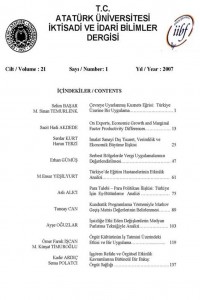Öz
Bu makale ihracat performansıyla ekonomik büyüme arasındaki
ilişkiyi incelemektedir. İhracat sektöründe kullanılan en son birim faktörün
(marjinal faktörün) diğer sektörlerdeki en son birim faktörden daha verimli olup
olmaması durumunun büyüme üzerindeki etkisini araştırmaktadır. İki sektörlü
bir model kullanmaktadır. İhracat sektöründen diğer sektörlere bir olumlu
dışsallık akışı bulunmuştur. Dışsallıklar ihracat sektöründe yüksek verimliliği
garanti etmemektedir. İhracata dayalı büyümeyi gerçekleştiren ülkelerin
başarısı ihracat sektörünün kaynakları daha etkin olarak kullanmasından
kaynaklanmamaktadır.
Anahtar Kelimeler
İhracat performansı Ekonomik büyüme Marjinal faktör verimliliği
Kaynakça
- Balassa, B. (1977), “Exports and economic growth: further evidence”, Journal of development economics 5, no.2, June, 181-189.
- Bernard, B. A. and Bradford, J.J.(1999), “Exporting and productivity”, NBER working paper no.7135, May.
- Bhagwati, J.,(1978), Foreign Trade regimes and economic development: anatomy and consequences of exchange control regimes, NBER, New York, 1978.
- Chenery, H.B, (1980), “The semi-industrialized countries”, World Bank Working Paper, Washnigton D.C.
- Feder, G. (1982),“On exports and economic growth”, Journal of development Economics 12, 59-73.
- Fry, M., (1988), Money, Interest, and banking in Economic Development, Baltimore: John Hopkins University Press.
- Hutchison, M. and Singh, N.(1992), “Exports and externalities. A granger causality approach”, International economic journal, Vol. 6, No.2, Summer
- Krueger, A. 0. (1980), “Trade policy as an input to development”, American Economic Review, 70, no.2, May, 288-292.
- Kunst M. R. and Marin, D. (1989), “On exports and productivity: a casual analysis”, The Review of Economics and Statistics, vol 71, No.4, November, 699-703.
- Levin A., and Lakshmi K. R. (1997), “Complementaries between exports and human capital in economic growth: evidence from the semi- industrialized countries”, Economic Development and Cultural Change, Volume 46, Number 1, October, 155-174.
- Marin D. (1992), “Is the export-led growth hypothesis valid for industrialized countries”, The Review of Economic and Statistics, Vol.76, Number 4, November, 678-688.
- Toda, H.Y. and Yamamoto, T. (1995),“Statistical ınference in vestor autoregressions with possible integrated processes”, Journal of Econometrics 66, 225-250.
- Vernon, R.(1966), “International ınvestment and ınternational trade in the product cycle”, Quarterly Journal of Economics, 80, 290-307.
- Xu Z. (1996), “On the causality between export growth and GDP growth: an empirical reinvestigation”, Review of International Economics, Vol. 4, Issue 2, June, 172-184.
- Yamada, H. (1998), “A note on the causality between exports and productivity. An empirical re-examination”, Economics Letters 61, 111-114.
Öz
Kaynakça
- Balassa, B. (1977), “Exports and economic growth: further evidence”, Journal of development economics 5, no.2, June, 181-189.
- Bernard, B. A. and Bradford, J.J.(1999), “Exporting and productivity”, NBER working paper no.7135, May.
- Bhagwati, J.,(1978), Foreign Trade regimes and economic development: anatomy and consequences of exchange control regimes, NBER, New York, 1978.
- Chenery, H.B, (1980), “The semi-industrialized countries”, World Bank Working Paper, Washnigton D.C.
- Feder, G. (1982),“On exports and economic growth”, Journal of development Economics 12, 59-73.
- Fry, M., (1988), Money, Interest, and banking in Economic Development, Baltimore: John Hopkins University Press.
- Hutchison, M. and Singh, N.(1992), “Exports and externalities. A granger causality approach”, International economic journal, Vol. 6, No.2, Summer
- Krueger, A. 0. (1980), “Trade policy as an input to development”, American Economic Review, 70, no.2, May, 288-292.
- Kunst M. R. and Marin, D. (1989), “On exports and productivity: a casual analysis”, The Review of Economics and Statistics, vol 71, No.4, November, 699-703.
- Levin A., and Lakshmi K. R. (1997), “Complementaries between exports and human capital in economic growth: evidence from the semi- industrialized countries”, Economic Development and Cultural Change, Volume 46, Number 1, October, 155-174.
- Marin D. (1992), “Is the export-led growth hypothesis valid for industrialized countries”, The Review of Economic and Statistics, Vol.76, Number 4, November, 678-688.
- Toda, H.Y. and Yamamoto, T. (1995),“Statistical ınference in vestor autoregressions with possible integrated processes”, Journal of Econometrics 66, 225-250.
- Vernon, R.(1966), “International ınvestment and ınternational trade in the product cycle”, Quarterly Journal of Economics, 80, 290-307.
- Xu Z. (1996), “On the causality between export growth and GDP growth: an empirical reinvestigation”, Review of International Economics, Vol. 4, Issue 2, June, 172-184.
- Yamada, H. (1998), “A note on the causality between exports and productivity. An empirical re-examination”, Economics Letters 61, 111-114.
Ayrıntılar
| Birincil Dil | tr;en |
|---|---|
| Bölüm | Makaleler |
| Yazarlar | |
| Yayımlanma Tarihi | 27 Kasım 2010 |
| Yayımlandığı Sayı | Yıl 2007 Cilt: 21 Sayı: 1 |





